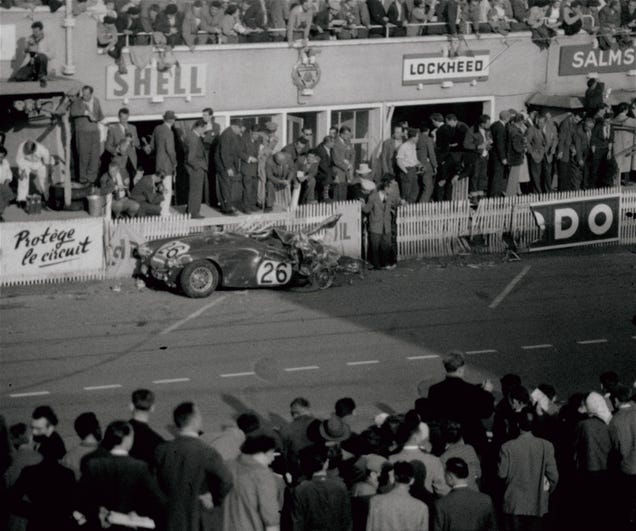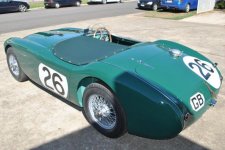aeronca65t
Great Pumpkin
Offline
Some of you realize that this is the 60th anniversary of the crash at LeMans. 83 people died as a result of that crash and it instituted a new era of safety for spectators of motorsports events everywhere.
I'm posting here because one of the three cars involved was Lance Macklin's Austin-Healey 100.
The fault of the actual crash has always been hard to exactly pinpoint but I think the greatest part of the blame was to Mike Hawthorn in his D-type Jaguar. The fact that he was using the new, efficient disk-type brakes was probably a contributing factor.
The BBC has marked the occasion by re-playing their 2010 interview with John Fitch:
https://www.bbc.co.uk/programmes/p00810tm
John's home track was Lime Rock (nearby me) and I saw him there many times. It's great to hear his voice again even about such a sad event.
Here's what Wikipedia says about that 1955 crash:
The 1955 24 Hours of Le Mans began on 11 June 1955, with Pierre Levegh behind the wheel of the #20 Mercedes-Benz 300 SLR run by Daimler-Benz. American John Fitch was Levegh's assigned partner in the car, and he would take over driving duties later. Competition between Mercedes, Jaguar, Porsche, Ferrari, Aston Martin and Maserati was close, with all the marques fighting for the top positions early on. The race was extremely fast, with lap records being repeatedly broken.[1]
At the end of Lap 35, Levegh was following Mike Hawthorn's leading Jaguar D-type, just as they were entering the pit straight. Hawthorn had just passed Lance Macklin's slower Austin-Healey 100 when he belatedly noticed a pit signal to stop for fuel. Hawthorn slowed suddenly in an effort to stop rather than make another lap. Hawthorn's Jaguar, with the new disc brakes, could decelerate much faster than other cars using drum brakes, such as Levegh's Mercedes. The sudden, unexpected braking by Hawthorn caused Macklin in the Healey to brake hard, throwing up a small cloud of dust in front of Levegh, who trailed close behind. Macklin then swerved across the centre of the track, attempting to re-pass the slowing Jaguar, but also apparently out of control.[1] Macklin had not noticed Levegh nor Juan Manuel Fangio, in another 300 SLR, approaching rapidly from behind. Fangio was in second place at the time, but directly behind, and attempting to lap Levegh.[1]
Levegh, ahead of Fangio on the track, did not have time to react. Levegh's car made contact with the left rear of Macklin's car as he closed rapidly (at about 240 km/h (150 mph)) upon the slowed car. When Levegh's 300 SLR hit Macklin's Austin-Healey from behind, his car became airborne, soaring towards the left side of the track, where it landed atop the earthen embankment separating spectators from the track itself. The car struck the mound at such speed and angle that it was launched into a somersault, which caused some parts of the car, already damaged and loosened by the collision, to be flung from the vehicle at very great speeds. This included the bonnet and the front axle, both of which separated from the frame and flew through the crowd.
Macklin's Austin-Healey post crash:

Macklin's Austin-Healey from a 2011 photo during an auction (it had been rebuilt after the crash). It sold for $1.3 million.

I'm posting here because one of the three cars involved was Lance Macklin's Austin-Healey 100.
The fault of the actual crash has always been hard to exactly pinpoint but I think the greatest part of the blame was to Mike Hawthorn in his D-type Jaguar. The fact that he was using the new, efficient disk-type brakes was probably a contributing factor.
The BBC has marked the occasion by re-playing their 2010 interview with John Fitch:
https://www.bbc.co.uk/programmes/p00810tm
John's home track was Lime Rock (nearby me) and I saw him there many times. It's great to hear his voice again even about such a sad event.
Here's what Wikipedia says about that 1955 crash:
The 1955 24 Hours of Le Mans began on 11 June 1955, with Pierre Levegh behind the wheel of the #20 Mercedes-Benz 300 SLR run by Daimler-Benz. American John Fitch was Levegh's assigned partner in the car, and he would take over driving duties later. Competition between Mercedes, Jaguar, Porsche, Ferrari, Aston Martin and Maserati was close, with all the marques fighting for the top positions early on. The race was extremely fast, with lap records being repeatedly broken.[1]
At the end of Lap 35, Levegh was following Mike Hawthorn's leading Jaguar D-type, just as they were entering the pit straight. Hawthorn had just passed Lance Macklin's slower Austin-Healey 100 when he belatedly noticed a pit signal to stop for fuel. Hawthorn slowed suddenly in an effort to stop rather than make another lap. Hawthorn's Jaguar, with the new disc brakes, could decelerate much faster than other cars using drum brakes, such as Levegh's Mercedes. The sudden, unexpected braking by Hawthorn caused Macklin in the Healey to brake hard, throwing up a small cloud of dust in front of Levegh, who trailed close behind. Macklin then swerved across the centre of the track, attempting to re-pass the slowing Jaguar, but also apparently out of control.[1] Macklin had not noticed Levegh nor Juan Manuel Fangio, in another 300 SLR, approaching rapidly from behind. Fangio was in second place at the time, but directly behind, and attempting to lap Levegh.[1]
Levegh, ahead of Fangio on the track, did not have time to react. Levegh's car made contact with the left rear of Macklin's car as he closed rapidly (at about 240 km/h (150 mph)) upon the slowed car. When Levegh's 300 SLR hit Macklin's Austin-Healey from behind, his car became airborne, soaring towards the left side of the track, where it landed atop the earthen embankment separating spectators from the track itself. The car struck the mound at such speed and angle that it was launched into a somersault, which caused some parts of the car, already damaged and loosened by the collision, to be flung from the vehicle at very great speeds. This included the bonnet and the front axle, both of which separated from the frame and flew through the crowd.
Macklin's Austin-Healey post crash:

Macklin's Austin-Healey from a 2011 photo during an auction (it had been rebuilt after the crash). It sold for $1.3 million.


 Hi Guest!
Hi Guest!

 smilie in place of the real @
smilie in place of the real @
 Pretty Please - add it to our Events forum(s) and add to the calendar! >>
Pretty Please - add it to our Events forum(s) and add to the calendar! >> 


